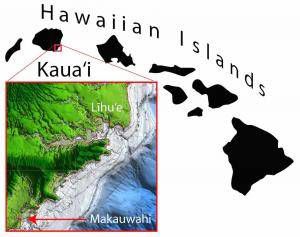LIHUE — Four-hundred-year-old coral fragments in Kauai’s Makauwahi Cave appear to have been left there by a tsunami generated by a magnitude 9 earthquake in the Aleutian Islands, according to a team who recently re-examined the cave. And researchers say
LIHUE — Four-hundred-year-old coral fragments in Kauai’s Makauwahi Cave appear to have been left there by a tsunami generated by a magnitude 9 earthquake in the Aleutian Islands, according to a team who recently re-examined the cave.
And researchers say there’s a 9 percent probability of such an event happening within the next 50 years.
If it happens again, an earthquake that size would send a tsunami that could flood Hawaii and decimate places along the coast of Washington and Oregon.
“Our knowledge of past events helps us to forecast tsunami effects and thereby enable us to assess this risk for Hawaii,” said Rhett Butler, geophysicist at the University of Hawaii at Manoa, who led the research team.
In the South Shore’s Makauwahi Cave, Butler re-examined mineral deposits and the coral fragments with other researchers.
The evidence was previously dated to the 16th century using carbon-14 methods, but Butler and his team narrowed down the timeline using specific isotopes of naturally occurring thorium and uranium in the coral fragments. That method returned a date of 1572, plus or minus 21 years. Carbon-14 dating had an uncertainty of plus or minus 120 years.
The fine-tuned age of the deposits and coral fragments allowed researchers to better compare the evidence to known tsunamis and earthquakes throughout the Pacific.
And for the first time, researchers connected the Kauai evidence with the 1586 tsunami that hit Sanriku, Japan — a tsunami with origins traditionally in Lima, Peru.
“Although we were aware of the 1586 Sanriku tsunami, the age of the Kauai deposit was too uncertain to establish a link,” said Butler. “After dating the corals, their more precise date matched with that of the Sanriku tsunami.”
Another look at the evidence from the 1586 Peruvian earthquake showed it wasn’t large enough to create a measurable tsunami that would hit Japan.
But, evidence from Kauai and the northeast coast of Japan was consistent with a mega-earthquake — having a magnitude of 9.5 or greater — in the Aleutian Islands.
“Hawaii is surrounded by the ‘ring of fire’ where mega-earthquakes generate great tsunamis impacting our island shores—the 2011 Tohoku Japan is the most recent example,” said Butler.
In May 2016, University of Hawaii researchers published a study looking at the probability of an earthquake or other event that would be able to generate a mega-tsunami that would swallow Hawaii as evidence suggests it did in the past.
A state of Hawaii report from the same year estimated such an event would cost $40 billion in damages and would affect more than 300,000 people.




